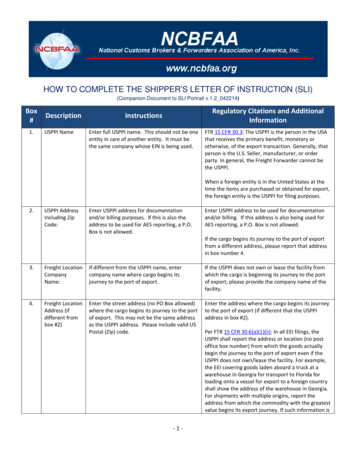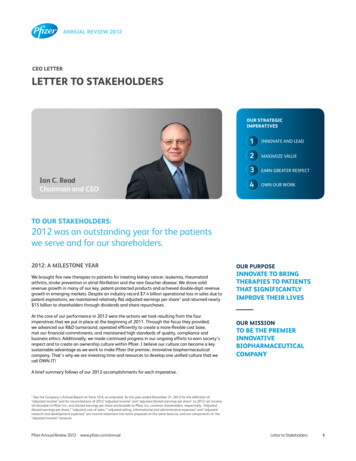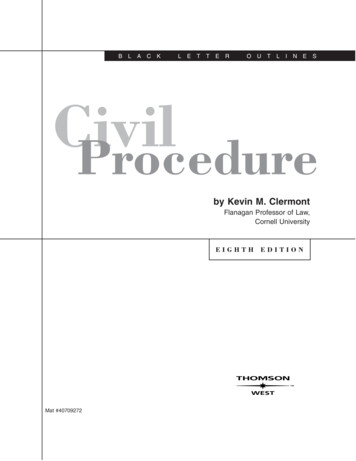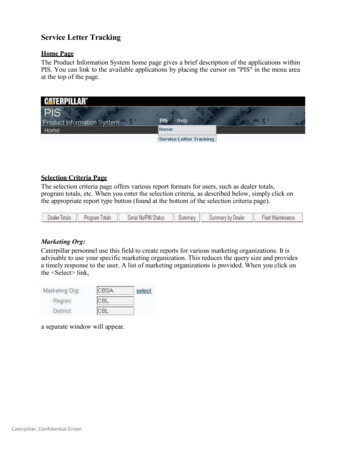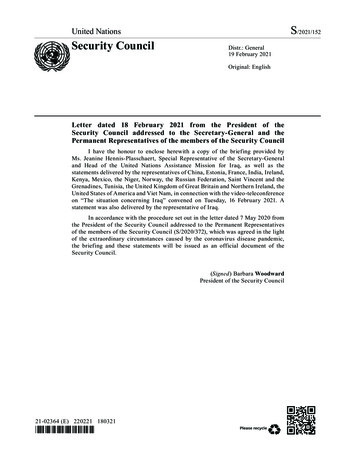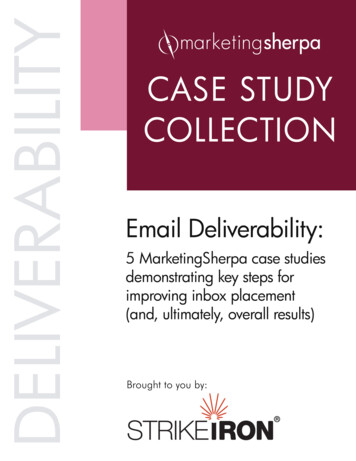
Transcription
L etterfrom theE ditorWelcome to this Case Study Collection, a compilation of complete MarketingSherpa case studies centered on avital marketing topic – in this case, email deliverability.Deliverability is a key challenge in email marketing strategies. At the most basic level, if a sent email isn’tdelivered for any reason, that individual marketing message is lost. At a higher level, deliverability issues cansubstantially impact the effectiveness of email marketing through affecting the ability to simply get emails intothe inbox.According to the MarketingSherpa 2013 Email Marketing Benchmark Report, 45% of surveyed marketers reportedthat “improve deliverability and inbox placement rates” was a 12-month organizational email marketing goal.To achieve deliverability and high inbox placement rates, email marketers must:1. Build a high-quality email subscription list: In the first case study you’re about to read, you can learnhow Publishers Clearing House built its list organically, largely through entries to sweepstakes.2. Validate the quality of the list: One tactic Publishers Clearing House utilized for maintaining the quality ofits list was sending emails to “seed lists” to ensure the email wasn’t blocked by spam filters. In the secondcase study, ArcaMax Publishing used external sources for list building and regularly audited the quality ofnew addresses coming from those sources.3. Track deliverability and email performance metrics throughout campaigns: The third case study featuresFedEx’s approach using email campaigns personalized to “preference centers” to improve both simplygetting into the inbox, and then improving engagement metrics such as click-to-open rates.4. Perform list hygiene by removing inactive subscribers: In the fourth case study, TBC Corporation soughtto improve deliverability and its email reputation score by running a campaign to cull its list of inactivesubscribers and boosted its sender score, inbox placement rate and overall deliverability in the process.5. Dramatic list hygiene can produce impressive results: Sometimes more is not better. In the case of theIndianapolis Symphony Orchestra, the fifth case study presented, “spray and pray” campaigns resultedin low response rates. The solution was to perform dramatic list hygiene and cut the subscriber base by95%. Even with the lower number of email recipients, online sales more than doubled.Deliverability issues will derail even the best constructed email marketing campaign, or even the overall emailmarketing strategy. It’s our hope that these case studies will provide some insight into how your marketing peersmet, and then tackled, deliverability challenges.David KirkpatrickManager of Editorial ContentMECLABS (parent company of MarketingSherpa)i Copyright 2014 MECLABS
T ableofC ontents5 Case Studies Showing How Companies are Improving Results withBetter DeliverabilityImproving Deliverability Through Organic List Building:How Publishers Clearing House uses “blacklisted” words yet achieves a 99.2%delivery rate .Decreasing Undeliverable Emails Through List Source Validation:How ArcaMax Publishing moves beyond double opt-in to avoid 1,000 hardbounces per day .Utilizing User Preference to Boost Deliverability and Clickthrough:How FedEx increases deliverability and clickthrough rates with preferencecenters .Increasing Deliverability by Removing Inactive Subscribers:How TBC Corporation increased delivery rate from 60% to 99% byseparating inactive subscribers .Reducing a Subscriber List to Increase Deliverability (and Even Revenue):How Indianapolis Symphony Orchestra cut a house list 95% and doubledsales .For permissions: research@meclabs.com17121925ii
“Poor-quality data is the biggest barrier to effective email marketing.”(Adestra Email Marketing Statistics, 2013)Email marketing has been around forever – or at least it seems like it has. Yet, it’s getting morecomplicated and risky every year. Marketers who rely on email as a primary form of communicationneed to be aware of the growing complexities around email marketing and the risks associated withpoor deliverability.What is that hissing sound? That’s all of the air escaping from your marketing plan. Think of allthe time and creative brainpower devoted to your email marketing efforts. Despite howcompelling your content or offer may be, your audience may not receive your message becauseof invalid email addresses on your list.Email verification and hygiene are proven techniques for cleansing your existing list and verifyingnew subscribers, so you can have the confidence of only sending to valid and safe email addresses.Ultimately, more delivered messages means higher open and clickthrough rates,increased conversions and more revenue generating opportunities.You can think of email verification and hygiene as an “email insurance policy” – protecting youagainst poor deliverability, missed customer opportunities, and the expensive and lengthy process ofremoval from blacklists.MarketingSherpa delivers the trusted information that is needed to better understand the risks andhow marketers should address their concerns. This Case Study Collection on Email Deliverability coversfive MarketingSherpa case studies demonstrating key steps for improving inbox placement (and,ultimately, overall results). Marketers rely on this trusted information and StrikeIron has partneredwith MarketingSherpa to make this Case Study Collection available as email hygiene grows inimportance.For more information on why marketers at Fortune 500 companies are relying on email verification andhygiene best practices as part of their overall email marketing strategy, read the white paper “EmailVerification Plus Hygiene: Best Practices for Marketers.”iii Copyright 2014 MECLABS
H ow P ublishers C learing H ouse uses “ blacklisted ”words yet achieves a 99.2% delivery rateby Adam T. Sutton, Senior ReporterPublishers Clearing House is a known authority in sweepstakes and direct mail marketing. But times havechanged. The company still focuses on sweepstakes, but digital marketing channels have risen to prominence.“We’re very dependent on email to be successful,” said SalTripi, Senior Director, Operations and Compliance, PublishersClearing House. “Protecting that channel, to us, is somethingwe invest very heavily in.”Publishers Clearing House (PCH) has millions of subscribersto its six email programs. Each program has a different themerelated to winning sweepstakes and prizes. A typical emailthe company sends achieves: 99.2% inbox delivery, as audited by a third-party30% to 40% of recipients clicking throughPublishers Clearing House workswith partners to help build its emaildatabase, but the company doesnot buy lists. Instead, partnersare required to drive visitors to aPCH registration page. “We do notacquire names other than by havingthem register on our acquisitionpages,” said Sal Tripi, Senior Director,Operations and Compliance.“We use our iconic sweepstakes to get consumers into ouremail program,” said Josh Glantz, Vice President and GeneralManager, Publishers Clearing House. “There are a lot ofmarketers who would probably ask how we retain those customers if all they are interested in are sweepstakes.”Indeed, misusing sweepstakes to build an email database can result in a high number of irrelevant subscribersand poor performance. PCH’s high-volume and high-performance email strategy, however, is based entirely onsweepstakes – proving that giveaways can have a part in an effective program.We sat down with Tripi and Glantz to better understand how an email program focused entirely on sweepstakescould be so effective. Here are the five tactics that drives their success.T actic #1: T akecontrol of acquisitionPublishers Clearing House works with partners to help build its email database, but the company does not buylists. Instead, partners are required to drive visitors to a PCH registration page.“We do not acquire names other than by having them register on our acquisition pages,” Tripi said. “We get a fullname and address from all.”For permissions: research@meclabs.com1
Visitors typically arrive on a PCH registration page to sign up for a sweepstakes. The page offers visitors the optionto opt-in to receive information about additional sweepstakes from PCH and its partners.Choose partners wiselyPCH thoroughly vets potential partners. Companies are required to fill out a brief survey to list business practices,IP addresses, domain names and other information. PCH uses this information to research the company’s emailreputation among webmail providers and ISPs.“We probably turn away more publishers than we accept when it comes down to it, because to us, the protectionof our brand is more important than any quantity of new members,” Tripi said.2 Copyright 2014 MECLABS
T actic #2: F ocuson relevant content and valuePeople who sign up to receive emails from a company have various motivations. Some want to receive moreinformation from a company they support. Others want to enter a sweepstakes the company is running.The problem with sweepstakes is that they are not always relevant to a company’s brand or email program.People trying to win a prize are not necessarily interested in an email newsletter. Such subscribers can drag downoverall performance in a database.“If you’re running a sweepstakes or other promotion and you want to really drive success, the success does notjust come from getting people to register and sign up,” Glantz said. “The success is getting a relevant audience tosign up and opt-in to your email program and then be responsive.”PCH bypasses this issue by basing its emails entirely on sweepstakes. People who sign up for PCH’s emails aredoing so to enter a sweepstakes, and they can opt-in to receive information about more sweepstakes.PCH does not offer a typical “newsletter,” Tripi said, just information about new opportunities to win.Highlight relevant valueA person filling out one of PCH’s sweepstakes forms is obviously interested in winning prizes – that’s why they’reon the page. PCH tailors its messages to this motivation when encouraging visitors to opt-in. Here’s sample copyfrom one of its opt-in checkboxes:“YES! I’d like to be informed about chances to win prizes instantly from PCH Search&Win. I know I canunsubscribe at any time by clicking the unsub link or the ‘EZ Unsubscribe’ seal in any email.”T actic #3: I nvestin testing and optimizationPCH has a long history of marketing optimization carried over from decades as a high-volume direct mailer.The company has incorporated this testing culture into its email marketing. PCH has at least six peoplethroughout the organization who are “totally isolated from any other regular duties just to execute tests andreport,” Tripi said.“We spend an enormous amount of time, money and effort in testing and retesting. We execute about 30 to50 test emails or test segments every month just so we can really get our arms around what our consumers aresaying,” he added.When it comes to email, “nothing is assumed,” Tripi said.For permissions: research@meclabs.com3
The company tests emails’ subject lines, timing, content, audience and many other factors. The team sometimesuncovers surprises.“Most marketers say to keep emails nice and short with a big call-to-action. You know what? We found thatabsolutely is not the case with us. Our best performing emails probably contain 3,000 to 4,000 words and requirethe user to scroll down threefold,” Tripi said.List hygiene is “critical” to PCH’sdeliverability, Tripi said. Thecompany has screening systems forall incoming addresses to monitorfor typos and syntax errors. Also,inactive subscribers are routinelyremoved from the database. Theperiod of inactivity varies acrossPCH’s six email programs.T actic #4: E nsureemail deliveryEmail marketers have been warned for years against sendingemails about “prizes,” “sweepstakes” and many of PCH’s otherkey phrases. However, PCH maintains an average 99.2% inboxdelivery rate despite using these terms.Tripi highlighted several ways his team maintains this average.Multiple seed listsBefore sending a campaign, PCH’s marketers send it to two seedlists to ensure the email renders correctly and is not blocked bypopular spam filters. The marketers maintain a list of 40 accounts to receive test emails. They also use a thirdparty provider to maintain a list of about 400 seed accounts and monitor delivery.Clean the listList hygiene is “critical” to PCH’s deliverability, Tripi said. The company has screening systems for all incomingaddresses to monitor for typos and syntax errors. Also, inactive subscribers are routinely removed from thedatabase. The period of inactivity varies across PCH’s six email programs.“No member will remain on our list beyond at the furthermost 90 days, at the shortest two weeks, without somesort of onsite engagement,” Tripi said.Short- and medium-term analysisPCH has signed up for complaint feedback loops from major ISPs and webmail providers, which report to PCHwhen a subscriber marks an email as spam.PCH monitors these metrics and others for every campaign. It also aggregates subscriber engagement andcomplaint data over a four- to six-month period to look for any aberrations or slow-growing trends.4 Copyright 2014 MECLABS
Tactics mentioned aboveThe previous tactics mentioned in this article also contribute to PCH’s high delivery rate. First, the marketersensure only valid and relevant subscribers opt-in to the program. Second, they only deliver subscribers theinformation they were promised. Third, they constantly test emails and monitor metrics to ensure a high level ofengagement.Last, as you can see on this PCH registration form, the company makes it very clear in the check-box descriptionthat subscribers can opt-out at any time. This message is emphasized with two “EZ Unsubscribe” badges. All ofthese tactics help ensure PCH’s emails are delivered.For permissions: research@meclabs.com5
T actic #5: D isplayrelevant advertisingPCH does not buy third-party information about its subscribers, but the company is constantly learning about itsaudience. The information is gathered on a “first-party” basis, Tripi said, through registration forms, subscriberactivity and surveys.The marketers primarily use this information to segment their audience and offer relevant third-party advertising inemails. PCH is able to identify subscribers’ interests (such as cooking or saving money), match them with relevantadvertising partners and deliver the most relevant ads.The content in each of PCH’s six email programs is not typically customized for subscribers’ preference. However,the advertising in each email is always customized. This has the double benefit of sending subscribers more relevantoffers, as well as connecting PCH’s advertisers to more relevant subscribers.Originally published at: “Email Marketing: How Publishers Clearing House uses “blacklisted” words yet achieves a99.2% delivery rate”6 Copyright 2014 MECLABS
H ow A rca M ax P ublishing moves beyondto avoid 1,000 hard bounces per daydouble opt - inby Courtney Eckerle, Manager of Editorial Content“In our business, deliverability has become the mission critical function,” said Scott Wolf, President and CEO,ArcaMax Publishing.Primarily driven by email, ArcaMax Publishing is the premier publisher of consumer syndicated content online.“Anything you can imagine reading the newspaper, you can get from us,” Wolf said. “We go to the same sourcesthat the newspapers do and license content that readers typically are very familiar with, having grown up readingthem in the newspapers.”Wolf lists comic strips, columns, news, sports and entertainment content as some of the features the companylicenses and sends out. All of the content is free to readers, and ArcaMax collects revenue by selling advertising –which can make it a target for some spam filters.He categorized ArcaMax as “old timers in the space,” as it began publishing content online in 1999.“Pretty darn old when it comes to the Internet,” Wolf said.Its model has remained “pretty consistent” over the years, he said, because it has always added subscribers to itslist using double opt-in.“If there was a bad address that was submitted to us, it didn’t confirm. So, we really didn’t have that issue ofhaving bad data on our subscription files,” he said.Wolf said he felt pretty secure relying on that practice – after all, according to the MarketingSherpa 2013 EmailMarketing Benchmark Report, only 39% of marketers even maintain an opt-in only subscriber list.The stringent double opt-in practice has enabled the company to “survive like we have, and be able to grow,because we’ve been able to build a very solid reader base of people who want to get [emails] from us.”But, as ISPs have evolved in its approach to spam filtering, ArcaMax has become more diligent.“Deliverability has not been the challenge for us along the way that it has been for many, but as time has goneon, we’ve had to be more and more scrupulous in our practices,” Wolf said.The “spam issue,” he added, has become “an important part of our business it’s a constant challenge to alwaysstay abreast of what’s happening in the deliverability world.”For permissions: research@meclabs.com7
Sending advertising is an integral part of ArcaMax’s business model, so the issue for Wolf has been in reconcilingthe business model with a solid sender reputation.“People don’t want spam, and spam is always advertising,” Wolf said, “[so] how do you identify yourself as alegitimate sender?”The challenge that must be met, he said, is to “continue growing our business, get our mail delivered andgenerate revenue.”CAMPAIGNThe precipitating question that pushed Wolf to re-evaluate ArcaMax’s sole reliance on the double opt-insystem and begin this campaign was, “so how many confirmation emails are you mailing that aren’t really goodaddresses, and to what extent is that a problem?”“The truth was, I couldn’t answer that question,” he said. “Because we didn’t track it – these were people whodidn’t confirm, we were filtering them out and focusing on those who did, and growing our business that way.”The natural process the team had always relied on “was causing difficulty,” he said, because of the amount ofconfirmation emails they were sending.“Depending on how aggressive we are at any given time, we’re sending a lot of confirmation emails. We areaveraging anywhere in the 8,000 to 10,000 subscriber-per-day range,” he said.Starting in January, Wolf decided to integrate into the system a platform to cut down on the amount ofconfirmation emails ArcaMax was sending by discovering which external sources were sending them bad names.Up until they began this campaign, the team’s only clue about bad addresses was: “Do they confirm or not, andwhat percentage of them confirm but at that point, we’ve already emailed these people,” he said.From there, the team analyzes those sources to cut off bad names before the confirmation emails go out, and seeif there are changes they can make to increase the number of legitimate names coming in.Because running bad names through the team’s usual process might injure ArcaMax’s carefully built senderreputation, to stave off hard bounces, “it is advantageous to us to validate these names before we even sendthem an email,” Wolf said.“Deliverability is a fundamental part of our b
ultimately, overall results). Marketers rely on this trusted information and StrikeIron has partnered with MarketingSherpa to make this Case Study Collection available as email hygiene grows in importance. For more information on why marketers at Fo
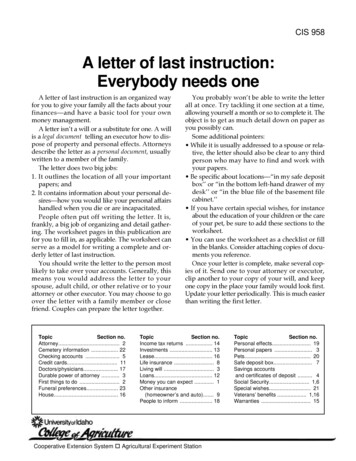
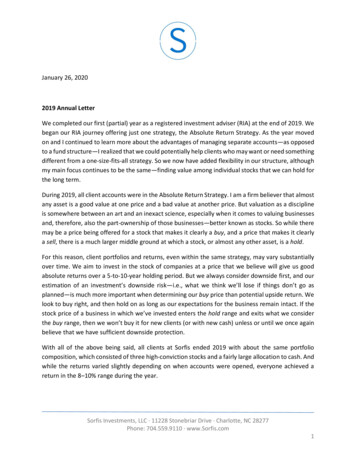

![Letter from Birmingham Jail (1963) [Abridged]](/img/2/1963-mlk-letter-abridged.jpg)
